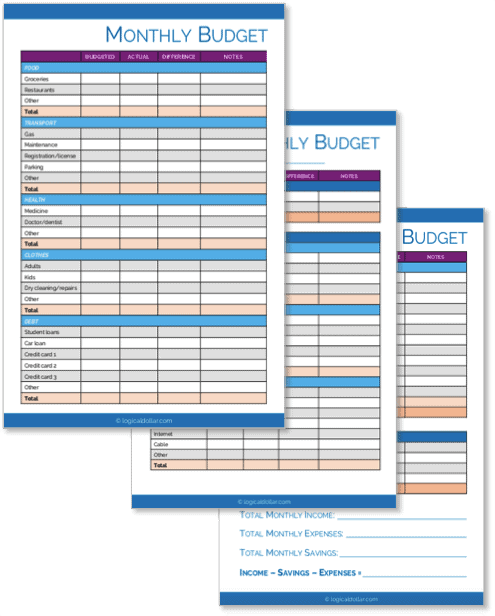You’ll often see people talking about their savings rate as an indication of how well they’re managing their money. But that then brings up the question of exactly how to calculate your savings rate.
After all, it’s certainly true that if you’re saving a large portion of your income and contributing it to your investments, including your retirement account, then you’re definitely putting yourself on the path to setting yourself up for the future, at least from a financial point of view.
This means that being able to calculate your savings rate is a good way to see how well you’re doing in terms of taking control of your money.

TAKE BACK CONTROL OF YOUR FINANCES
Our free budget planner will help you to quickly and easily take control of your money – instead of it controlling you.
Get it free for a limited time!
You’ll also join our mailing list to get updates on how to manage your money – unsubscribe at any time at the end of each email.
It’s also a great motivator for increasing your savings rate.
If, for example, you want to save 25% of your income but you do the math and realize you’re actually way below that, you can start to make adjustments to your spending to reach your saving goal.
As you’ll see, the calculation isn’t complicated. We’ve also made sure to keep things simple when trying to figure out what to include as savings or how to deal with tax.
But hopefully you’ll be pleasantly surprised when you see how well you’re doing!
How to calculate your savings rate
As promised, it’s very simple. In fact, you can calculate your savings rate just using the following formula:
Savings Rate = Total Savings ÷ Total Post-Tax Income x 100
Your total post-tax income should include any money flowing into your account, including salaries, pension or social security payments and any extra cash earned from side hustles or from one-off earnings, such as selling something.
Personal Capital
Our pick: Best money management app
Easily our choice for the best app to help you manage your money better.
Create a budget, track your spending automatically, receive personalized advice, get alerts about hidden fees and a ton more – and it’s all free.
How to calculate your post-tax income
You’ll notice that we’ve based this off net income (i.e. post-tax), not gross income (i.e. pre-tax). This is because this gives a much more accurate result when you calculate your savings rate, given you don’t get to keep your taxes, nor are you “spending” them in the normal sense.
That said, it’s true that it can be tricky to figure out exactly how much this is, so we’d recommend simply doing an estimate of how much you’ll owe in taxes for the purposes of this calculation.

The easiest way to do this is to base this amount on the taxes you’ve paid in previous years. This can be done as follows:
- Check your tax return from last year to see your total tax paid and your total income
- Do the calculation: Total tax paid last year / Total income last year
- Now calculate: Total pre-tax income this year x The result of the previous calculation
- And finally: Total pre-tax income this year – The answer you just got from the last calculation
And now you have a pretty good estimate of your total post-tax income.
(This assumes that your income is fairly similar to last year and that there hasn’t been a massive overhaul to the tax laws where you are. On that second point, you probably would have heard about it if that had happened, so I wouldn’t bother looking into it too deeply if you haven’t heard otherwise.)
Using an estimate may sound like cheating, but this calculation isn’t forensic accounting-level accurate, so it’s ok if there’s some guesswork involved. Just make sure it doesn’t involve pulling numbers completely out of thin air so you don’t stray too far from what the actual figures likely are.
And this then brings up the next question: how to calculate your total savings.
How to calculate your total savings?
On a simple level, the savings formula can be calculated as follows:
Total Savings = money you allocate to your savings + money you allocate to investments + money you allocate as retirement contributions + matching contributions by your employer
So what doesn’t this include?
Debt repayments
Firstly, it doesn’t include debt repayments, which we consider as spending. This includes not counting mortgage repayments for the house you live in.
This is because the house you live in isn’t considered as an investment, even though (ideally) its value will go up over time. If you ever sell it, any post-tax gains you make can then be counted as income.
The other reason is any interest you’re paying on your mortgage is definitely spending. This means that the portion of your mortgage repayment that goes towards the principal could theoretically be counted as savings. However, in my opinion, it’s simply not worth the hassle of figuring this out.

Instead, it’s far easier to not consider your mortgage payments as savings. Then, when you pay off your home, all that money you were putting towards this each month can be transferred to the savings column to be allocated to things like your retirement.
Non-financial employer benefits
It also doesn’t include any non-cash benefits your employer provides, such as health insurance.
While perks like this definitely have a financial benefit for you and any other beneficiaries, in that you hopefully won’t be facing massive medical bills if something happens, they don’t count as savings.
Why do you need to calculate your savings rate?
Knowing how to calculate your savings rate can be a great motivator for working on your financial management. Some of the specific reasons for doing this include the following:
- It gives you a benchmark for assessing your financial management – By letting you calculate exactly how much of your money is being saved, you’ll be able to see whether this is as high as you want it to be in light of your financial goals.
- It gives you something to track when trying to improve your financial management – Sure, knowing how to calculate your savings rate can let you see where you are now. But it’s also something you can keep track of from month-to-month to try to save more and thus increase your savings rate.
- It gives you a goal – If you’re wondering how to calculate your savings rate based on the rate you want to be saving at so that you can treat this number as a goal, you can do that as follows:
Amount of Savings Needed to Reach Target Savings Rate = Total Post-Tax Income x Target Savings Rate ÷ 100
How do you calculate your monthly savings rate?
Knowing how to calculate your monthly savings rate is particularly good for tracking your progress on a month-to-month basis, especially if you’re trying to increase your overall savings rate.
And the calculations mentioned above all work on a monthly basis, assuming you use the amounts you’ve saved and earned that month rather than the full year.
If, however, your income or savings tend to fluctuate each month for whatever reason, it’s best to either give an informed estimate of what these are (i.e. based on previous months or other information you have on hand) or work out the annual total for each figure and divide it by 12.
As mentioned, knowing how to calculate your savings rate doesn’t have to be an exact science. The more important part is getting an idea of what this is which is as close to being accurate as it can – without making the calculation impossible to do. Otherwise, you’re simply not going to do it.

MANAGE YOUR MONEY LIKE A BOSS
Managing your money effectively can literally change your life. And starting a budget using our budget planner is the first step towards you doing just that.
Get it free for a limited time!
You’ll also join our mailing list to get updates on how to manage your money – unsubscribe at any time at the end of each email.
How much should I save each month?
The simple answer to how much should you save each month is: as much as you can!
But really, it’s going to come down to a lot of things that are specific to your circumstances, including your income. After all, someone with a six-figure income is generally going to be able to save more than someone earning minimum wage.

That’s why it’s hard to answer questions such as “Is saving $1000 a month good?” or even “Is saving $500 a month good?”.
And it’s also why it’s far better to consider this question based on your savings rate, not your total savings.
Related: SaveBetter Review: Your Key to High Interest Savings?
What should my savings rate be?
This, of course, brings us to the question of what should your savings rate be – and, again, the answer is: as high as you can get it!
A general rule of thumb is that you should be saving at least 20% to 25% of your post-tax income. Again, though, this may be difficult for you depending on how much debt you’re carrying, what your expenses are and how high your income is.
If you’re barely saving anything at the moment, I’d strongly recommend starting with a goal of saving at least 10% of your income.
You can then work up from there by making adjustments to your spending, focusing on paying off debt and even increasing your income through side hustles.
While it may seem tough to save more than you are currently, remember that the more you save now, the earlier you’ll be able to retire. Meaning that the more you delay making these changes to your finances, the longer it will take for you to live without working.
Related: How to Drastically Cut Expenses: 43 Easy Ways That Actually Work
What is a good savings rate for retirement?
What is a good savings rate for retirement is going to depend on a few things, namely:
- How much money you want to have when you retire; and
- How long you have until you reach retirement.
For example, someone who’s 30 years away from retirement and wants to have $1,000,000 by then is clearly going to need to have a lower savings rate than someone who’s 15 years away from retirement but is looking to save $2,000,000 to sustain themselves when they reach that point.
To figure this out, there are plenty of calculators online that you can search for. But the first step is going to be working out the two numbers mentioned above.
Related: The Personal Financial Plan Example You Can Use To Reach Your Financial Goals
Is a 50% savings rate possible – or even a 75% savings rate?
You may have read articles talking about people with a 50% savings rate or even higher, including a 75% savings rate or more.
In fact, if you know anything about the FIRE movement, which stands for “Financial Independence Retire Early”, saving more than 50% of your income is consistently considered the optimal FIRE savings rate.
This means that it’s entirely possible to have a high savings rate like these.

That said, it’s going to mostly rely on you doing a few things:
- Having a higher than average income
- Living as cheaply as you can
This isn’t to say that you have to be earning hundreds of thousands of dollars a year or only eat microwave noodles to get to that kind of savings rate.
But it’s going to be almost impossible to do if you don’t have a fairly strong income and if you aren’t able to exercise close control over your finances.
This means no lifestyle creep or wasting money on things you don’t need and absolutely no high-interest debt (or possibly even any debt at all).
Instead, you’ll be keeping your eye on the financial prize by making sure your money is being put to its best use possible, like contributing to your investments.
These people who’ve been able to calculate their savings rate on Reddit may help to give you some idea of how this can be done based on a range of incomes.
Related: What’s the Cheapest Way to Live: Where to Move Abroad and 21 Other Cheap Living Tips
How to calculate the savings rate needed to reach a savings goal
To know how to calculate the savings rate needed to reach your savings goal, it’s good to start with knowing the formula for this:
Savings Rate Needed to Reach Savings Goal = (Savings Goal ÷ Number of Years to Reach Savings Goal) ÷ Annual Post-Tax Income x 100
These examples show how this can be done.
How can I save $50k in 3 years?
Working out how to calculate the savings rate needed to reach your savings goal will always depend on your income.
Let’s assume you have a post-tax annual income of $70,000 when wanting to save $50k in 3 years.
The calculation would be:
(50,000 ÷ 3) ÷ 70,000 x 100
= 16,666.67 ÷ 70,000 x 100 = 23.8
This means that you’d have to have an annual savings rate during the next three years of just under 24%, which is absolutely doable.
How can I save $100k in 3 years?
Let’s see what to do if you’re trying to work out if you can save $100k in 3 years on that same $70,000 salary.
Of course, you can just double the result from the last calculation, but let’s set it out to show how it works.
(100,000 ÷ 3) ÷ 70,000 x 100
= 33,333.33 ÷ 70,000 x 100 = 47.6
Now you’re looking at a savings rate of close to 50% of your take home pay, which is going to take a bit more work.
That said, it’s certainly possible, especially if you seriously cut your spending.
And hopefully having a savings target will serve as good motivation for you to make the changes needed to your financial habits to easily achieve that goal.
Related: What’s the Point of a Savings Account? (Pros and Cons)
Is having $100k in savings good?
You may be looking at these examples and thinking about setting your own savings goals, including wondering whether having $100k in savings is good.
As with most of the questions in this post, the answer is: it depends.
Having $25k in savings is good if you’re in your 20s but is going to be an issue if you’re in your 50s and hoping to retire in the next decade or so.
Similarly, having $100k in savings is good if you’re younger, but problematic if you’re in your 60s and that’s all you have to retire on.
That said, the question of how much money you should have saved by 25 compared to the amount you should have by 40 years old isn’t just dependent on your age. It will also depend on when you want to retire and how much you want to have saved by then.
So take a look at the section above on what is a good savings rate for retirement and this will help you to figure out if your savings goals are going to work for you.
Final thoughts on calculating your savings rate
As you can see, working out how to calculate your savings rate isn’t complicated and there are some great benefits in doing so.
It can serve as a pat on the back if you’re doing better than you thought. Alternatively, it could show you that you’re not quite on track to reach your goals, meaning that some tweaks may be needed to your spending habits.
And then flipping around the savings rate calculation can also help you to figure out how much you should be saving to get to your goal savings rate or even what your savings rate should be to reach that goal.
Either way, it’s safe to say that when it comes to savings rates: bigger is definitely better.

READY FOR MORE?
Join thousands of subscribers in getting regular tips in your inbox on how to take control of your finances and save more money – and, for a limited time, get our free budget planner as a gift!
You’ll also join our mailing list to get updates on how to manage your money – unsubscribe at any time at the end of each email.






